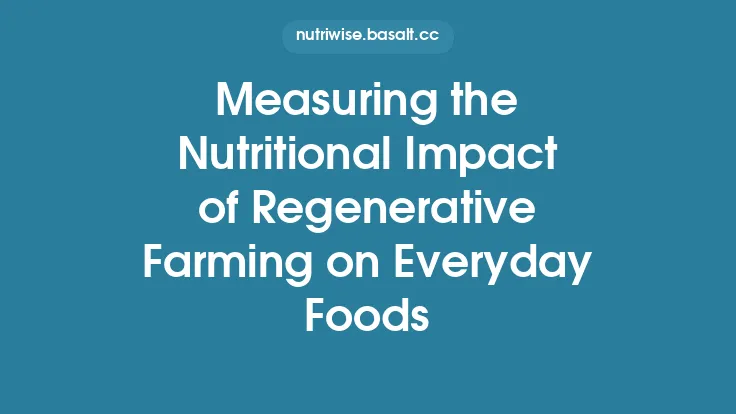Food processing, in its many forms, reshapes the nutritional landscape of the foods we eat. While processing can improve safety, extend shelf life, and enhance convenience, it also has profound effects on the quality of the three macronutrients—protein, carbohydrate, and fat—that supply the body’s energy and building blocks. Understanding how different processing techniques alter macronutrient composition, structure, and bioavailability is essential for making informed choices that support long‑term health.
Understanding the Spectrum of Food Processing
Food processing is not a single, monolithic activity; it ranges from simple mechanical actions (washing, cutting, freezing) to complex chemical and physical transformations (hydrogenation, extrusion, high‑pressure processing). The NOVA classification system, widely used in nutrition research, groups foods into four categories:
- Unprocessed or minimally processed – natural foods altered only to make them edible or storable (e.g., washed vegetables, frozen berries).
- Processed culinary ingredients – substances extracted from whole foods for cooking (e.g., oils, sugar, salt).
- Processed foods – items that have been altered for preservation or palatability (e.g., canned legumes, cheese, smoked fish).
- Ultra‑processed foods – formulations containing multiple industrial ingredients and additives (e.g., sweetened beverages, ready‑to‑eat meals, mass‑produced snack bars).
Each step along this continuum can modify macronutrient quality through physical disruption, chemical reactions, or the addition of non‑nutritive components. The impact is not uniformly negative; some processes enhance digestibility or nutrient availability, while others degrade essential structures.
Protein Quality and Processing
Structural Alterations
Proteins are composed of long chains of amino acids folded into specific three‑dimensional structures. Processing can:
- Denature proteins, unfolding them and exposing peptide bonds. Heat‑based methods (boiling, grilling, extrusion) typically cause denaturation, which can increase digestibility because digestive enzymes gain easier access to the protein backbone.
- Aggregate proteins through the formation of disulfide bonds or non‑covalent interactions, especially during high‑temperature, low‑moisture processes (e.g., roasting, spray‑drying). Aggregation can reduce solubility and limit enzyme access, lowering digestibility.
Amino Acid Profile Shifts
Certain amino acids are heat‑labile:
- Lysine reacts readily with reducing sugars in the Maillard reaction, forming complexes that are less bioavailable. This is a common issue in baked goods, dried milk powders, and roasted nuts.
- Tryptophan is sensitive to oxidation and can be degraded during prolonged heating or exposure to light, diminishing its contribution to protein quality.
Enzymatic and Fermentation Effects
- Fermentation (e.g., tempeh, sourdough) activates endogenous proteases that partially hydrolyze proteins, improving digestibility and sometimes enriching the profile of essential amino acids.
- Enzymatic tenderization in meat processing (using papain or bromelain) can similarly increase protein accessibility but may also generate bioactive peptides with functional properties.
Net Impact on Protein Quality
Overall, moderate heat and controlled fermentation tend to preserve or even enhance protein quality, whereas excessive high‑temperature, low‑moisture processing and the addition of reducing sugars can diminish essential amino acid availability. The Protein Digestibility‑Corrected Amino Acid Score (PDCAAS) or the newer Digestible Indispensable Amino Acid Score (DIAAS) can be used to quantify these changes in processed foods.
Carbohydrate Structure and Processing
Starch Modification
Starch, the primary carbohydrate in many plant foods, exists as two polymers: amylose (linear) and amylopectin (branched). Processing influences its structure in several ways:
- Gelatinization – heating starch in the presence of water disrupts crystalline regions, making the granules swell and become more digestible. This occurs in cooking, baking, and extrusion, often raising the glycemic response.
- Retrogradation – upon cooling, gelatinized starch can re‑associate into ordered structures that resist digestion, forming resistant starch type 3 (RS3). This is common in cooled cooked potatoes, rice, and certain processed breads.
- Pre‑gelatinized starches – added during industrial processing to improve texture; they are already partially gelatinized, leading to rapid glucose release.
Fiber Integrity
- Mechanical refining (e.g., milling wheat into refined flour) removes the bran and germ, stripping away insoluble fiber and many bioactive compounds. The resulting product has a higher proportion of rapidly digestible carbohydrates.
- Physical treatments such as high‑pressure processing or micronization can break down cell walls, increasing the extractability of soluble fiber but potentially reducing the functional benefits of intact fiber matrices.
Sugar Addition and Replacement
- Concentration of sugars through processes like evaporation (e.g., syrup production) raises the proportion of simple carbohydrates, directly influencing the overall glycemic load.
- Sugar alcohols and polyols (e.g., sorbitol, erythritol) are often introduced in “reduced‑sugar” processed foods. While they contribute fewer calories, they can affect gut microbiota and may cause gastrointestinal discomfort at high intakes.
Net Impact on Carbohydrate Quality
Processing that preserves or creates resistant starches and maintains fiber integrity supports a more favorable post‑prandial glucose profile. Conversely, extensive refining, excessive gelatinization, and the addition of free sugars shift the carbohydrate pool toward rapidly digestible forms, increasing glycemic response and potentially contributing to metabolic dysregulation.
Fat Integrity and Processing
Oxidative Stability
Fats are susceptible to oxidation, especially polyunsaturated fatty acids (PUFAs). Processing influences this in several ways:
- Heat and Light Exposure – frying, baking, and prolonged storage under light accelerate lipid peroxidation, generating primary oxidation products (hydroperoxides) and secondary compounds (aldehydes, ketones) that can impair nutritional quality and flavor.
- Metal Catalysis – trace metals (iron, copper) introduced during processing (e.g., from equipment) can catalyze oxidation, especially in high‑temperature oil refining.
Hydrogenation and Trans Fat Formation
- Partial hydrogenation converts some cis‑double bonds in unsaturated fats to trans configurations, creating trans fatty acids (TFAs). TFAs have been linked to adverse lipid profiles and inflammation. While many jurisdictions have limited industrial TFAs, they may still appear in certain ultra‑processed products.
Fatty Acid Profile Shifts
- Refining and deodorization of vegetable oils can strip minor components such as tocopherols (vitamin E) and phytosterols, reducing the antioxidant capacity of the oil.
- Fractionation separates oils into solid (stearin) and liquid (olein) fractions, altering the balance of saturated and unsaturated fats. This can be used to create spreads with specific melting properties but may increase saturated fat content.
Structured Lipids
- Interestification (rearranging fatty acids on the glycerol backbone) produces structured lipids with tailored melting points and digestibility. While technically sophisticated, these modifications can affect the metabolic response to dietary fat.
Net Impact on Fat Quality
Processing that minimizes oxidation (e.g., rapid cooling, inert atmosphere packaging) and avoids unnecessary hydrogenation preserves the functional and health‑promoting properties of dietary fats. Conversely, high‑temperature, prolonged exposure to air and light, as well as the use of partially hydrogenated oils, degrade fat quality and introduce potentially harmful compounds.
Processing‑Induced Compounds and Their Effects on Macronutrients
Maillard Reaction Products (MRPs)
When reducing sugars react with amino acids under heat, a cascade of MRPs forms. Some MRPs, such as melanoidins, contribute to flavor and color, but others can:
- Bind lysine, reducing its availability for protein synthesis.
- Generate advanced glycation end‑products (AGEs), which have been implicated in oxidative stress and inflammation when consumed in large amounts.
Acrylamide and Other Heat‑Generated Toxins
Acrylamide forms from asparagine and reducing sugars during high‑temperature cooking (e.g., frying, baking). While primarily a concern for neurotoxicity, its presence signals extensive carbohydrate degradation.
Lipid Oxidation Products
Secondary oxidation products like 4‑hydroxynonenal (4‑HNE) can modify proteins and DNA, potentially impairing cellular function. Their formation is a marker of fat quality loss.
Enzyme Inactivation
Processing often inactivates endogenous enzymes (e.g., lipases, amylases) that would otherwise continue to modify macronutrients post‑harvest. While this can stabilize food, it also halts beneficial enzymatic transformations that improve digestibility.
Strategies to Preserve Macronutrient Quality During Processing
- Control Temperature and Time – Applying the lowest effective heat and limiting exposure duration reduces protein denaturation, Maillard reactions, and lipid oxidation.
- Use Antioxidant‑Rich Ingredients – Incorporating natural antioxidants (e.g., rosemary extract, tocopherols) can protect fats from oxidative damage.
- Employ Modified Atmosphere Packaging (MAP) – Reducing oxygen levels in packaging slows lipid oxidation and preserves color and flavor.
- Select Gentle Mechanical Processes – Low‑shear grinding and minimal milling retain fiber structure and limit starch gelatinization.
- Utilize Fermentation and Enzymatic Treatments – Controlled fermentation can improve protein digestibility and generate beneficial bioactive peptides without excessive heat.
- Implement High‑Pressure Processing (HPP) – HPP inactivates microbes while preserving native macronutrient structures, offering a non‑thermal alternative to pasteurization.
- Avoid Partial Hydrogenation – Opt for fully hydrogenated oils followed by interesterification, or use naturally stable fats (e.g., palm oil) when solid fats are required.
- Monitor Moisture Content – Proper drying reduces water activity, limiting microbial growth while preventing excessive starch retrogradation that could affect texture.
Practical Guidance for Consumers
- Read beyond the ingredient list – While labels are not the focus here, noticing terms like “extruded,” “hydrolyzed,” or “partially hydrogenated” can hint at processing intensity.
- Prefer minimally processed forms – Frozen vegetables, canned legumes (rinsed), and plain yogurts retain more of their original macronutrient quality than heavily flavored, ultra‑processed counterparts.
- Reheat wisely – When reheating processed foods, use moderate temperatures and avoid prolonged high heat to limit further protein and fat degradation.
- Combine processing methods – Pairing gentle cooking (steaming) with short, high‑heat finishing (grilling) can achieve desirable texture while preserving macronutrient integrity.
- Store appropriately – Keep oils in dark, cool places; freeze high‑fat foods to slow oxidation; consume processed carbohydrate products promptly to avoid staling and retrogradation.
Concluding Perspective
Food processing is an indispensable component of modern food systems, delivering safety, convenience, and culinary diversity. Yet, each processing step carries the potential to alter the intrinsic quality of proteins, carbohydrates, and fats. By recognizing the mechanisms—thermal denaturation, Maillard reactions, oxidation, and structural modifications—consumers, manufacturers, and policymakers can make choices that safeguard macronutrient integrity. The goal is not to reject processing altogether but to harness it intelligently, ensuring that the macronutrients we rely on for energy and growth remain as nutritious and functional as possible.





